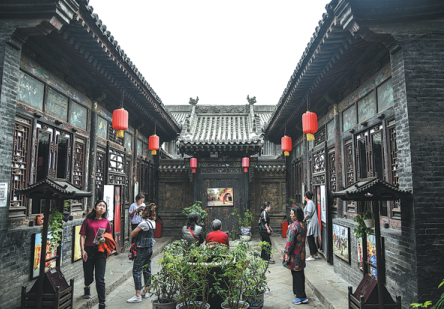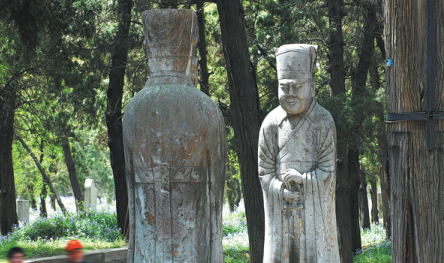Yellow River civilization
Rich historical sites along the waterway are worth a visit with bountiful relics detailing cultural development, Yang Feiyue reports.
The steep canyons, deserts and grasslands make the natural landscape of the Yellow River basin magnificent and beautiful. The basin also has many cultural relics. Along the river path, there are 20 World Heritage Sites, more than 300,000 non-movable cultural relics, 649 national intangible cultural heritages, 47 national holistic tourism demonstration areas and 84 national top-rated tourist attractions.
In September 2019, President Xi Jinping emphasized the importance of ecological conservation and high-quality development of the Yellow River basin. Xi says that protecting the Yellow River-China's second-longest river at 5,464 kilometers-is crucial to national rejuvenation and the sustainable development of future generations.
The Ministry of Culture and Tourism recently launched 10 themed routes around the Yellow River. China Daily takes a look at some of the highlights.
Civilization charm
Both the Yangtze River and the Yellow River have nurtured the nation and bred Chinese civilization. A number of museums in the region showcase the great charm the civilization holds.
・ Qinghai Museum
Located mostly on the Qinghai-Tibet Plateau, Northwest China's Qinghai province has long been a melting pot for ethnic groups including the Han, Tibetan, Hui, Tu and Mongolian. The Qinghai Museum preserves a collection of more than 14,000 cultural relics. It is especially known for the chipped stone tools from the Paleolithic Age, colored pottery from the Neolithic Age, bronze mirrors and inscriptions from the Han (206 BC-AD 220) and Tang dynasties (618-907), paper money and stone statues from the Yuan Dynasty (1271-1368), and porcelain and paintings from the Ming (1368-1644) and Qing dynasties (1644-1911).
・ Ningxia Museum
The museum is a great place to spend an afternoon in Yinchuan, the Ningxia Hui autonomous region. There are a vast array of exhibits ranging from historical records and texts dating back to more than 1,000 years ago to the remains from prehistoric inhabitants of Ningxia, including primitive tools and artifacts, stone weaponry, jade ware, ancient currencies and totems.
・ Inner Mongolia Museum
The museum displays a large number of fossils from paleontological eras, including dinosaurs from across the Inner Mongolia autonomous region. There are also 44,000 relics bearing witness to life in ancient times. In particular, Mongolian female clothing from different places and statues as well as religious relics are the biggest attractions for most visitors to the museum.
・ Shanxi Museum
The museum in Shanxi province houses over 400,000 cultural relics, epitomizing historical and cultural development in Shanxi over a long course of history. The museum has exhibitions that follow history in chronological order and showcase highlights of civilization. The exhibits also define the unique contributions Shanxi has made to the 5,000-year evolution of Chinese civilization.
・ Henan Museum
Located in Henan province, the museum is home to a collection of 170,000 relics and is particularly known for its prehistoric artifacts, bronzes from the Shang Dynasty (c.16th century-11th century BC) and the Western Zhou Dynasty (c.11th century-771 BC), as well as ceramics and jade ware. The central plain area is a major cradle for Chinese civilization to thrive, and cultural relics from the museum are testament to the development of Chinese civilization and history.
・ Shandong Museum
The museum from East China's Shandong province hosts a collection of historical bronze vessels, paintings and calligraphy works, rare books, as well as animal and plant specimens and ancient fossils. Not to be missed are relics bearing the Neolithic Dawenkou and Longshan cultural elements, bronze artifacts from the Shang and the Western Zhou dynasties, and stone carvings from the Han Dynasty.
World heritage sites
・ Sichuan Giant Panda Sanctuaries
In Southwest China's Sichuan province, the sanctuaries are home to more than 30 percent of the world's pandas. It covers 924,500 hectares with seven nature reserves and nine scenic parks in the Qionglai and Jiajin mountains. Visitors can see other endangered animals including the red panda, snow leopard and clouded leopard here. The sanctuaries are among the richest botanical sites with 5,000-6,000 species of flora in over 1,000 genera.
・ Emperor Qinshihuang's Mausoleum Site Museum
Buried deep under a hill in Xi'an, the museum in Northwest China's Shaanxi province offers a look at Terracotta Warriors from more than 2,000 years ago. These sculptures are the afterlife garrison force protecting the mausoleum of China's first emperor who created the first unified nation of China. More than 7,000 terracotta sculptures of soldiers, horses, chariots and weapons have been discovered in the excavations and are displayed at the museum.
・ Site of Xanadu
The site sits in Xilingol League in Inner Mongolia. It is one of the best preserved sites of capital cities of the Yuan Dynasty in China. Covering 25,000 hectares, the site was a unique attempt to assimilate the nomadic Mongolian and Han Chinese cultures. The site was planned according to traditional Chinese feng shui in relation to the nearby mountains and river. There are temples, palaces, tombs and nomadic encampments at the site, reflecting the clashes and blending of grassland cultures.
・ Mount Wutai
Located in Shanxi province, the mountain features five flat peaks. It is considered a holy place of Buddhism and has a great number of temples. Temples have been built on this site from the 1st century AD to the early 20th century. Dating from AD 857, the main hall of Foguang Temple is one of the oldest surviving wooden buildings in the country. The buildings on site showcase the way in which Buddhist architecture developed and influenced palace buildings in China for over a millennium.
・ Ancient city of Pingyao
The county-level city in Shanxi province retains ancient walls, streets, shops, dwellings and temples of the Han people from the 14th to 20th century. Its layout reflects the development of Chinese architectural style and urban planning over more than five centuries. Pingyao was a financial center from the 19th century to the early 20th century, and the nearly 4,000 existing exquisite ornamental shops and traditional dwellings in the town have witnessed the city's economic prosperity of over a century.
Natural relics
Grotto temples are an important part of China's cultural relics and pearls in the long river of civilization. They integrate architecture, sculpture, frescoes, calligraphy and other artworks.
・ Mogao Caves
This is a shrine of Buddhist art treasures in Dunhuang, Northwest China's Gansu province. It was first constructed in 366 AD and preserves 492 caves that house about 45,000 square meters of murals and more than 2,000 painted sculptures. Visitors can view one of the oldest and most vivid scenes of cultural exchanges along the Silk Road.
・ Tianti Mountain Grottoes
Located in Wuwei in Gansu province, it was built in Northern Liang of the Eastern Jin Dynasty (317-420) and has a history of more than 1,600 years. The mountain peaks are tall and rugged, and the bumpy path resembles a hanging ladder on the mountain. Its relics were relocated in the 1950s to make way for local reservoir construction. Most of the relocated relics, including frescos and colored statues, were brought back to the mountain in 2006.
・ Yungang Grottoes
The grottoes feature 252 caves and 51,000 statues in Datong, Shanxi province, and they represent outstanding achievements of Buddhist cave art in the 5th and 6th centuries. Visitors can appreciate the strict unity in layout and design of the artworks. The statues in the caves and niches are in good condition, with the eaves of wooden pavilions in the caves and related historical remains maintained like when they were first constructed.
・ Longmen Grottoes
The grottoes in Luoyang, Henan province, are home to more than 2,300 caves and niches carved into steep limestone cliffs over a 1-kilometer stretch. The grottoes and niches have an impressive collection of Chinese art from the late Northern Wei (386-534) to Tang dynasties. They include about 110,000 Buddhist stone statues, more than 60 stupas and 2,800 inscriptions carved on steles.
There still remains more fascinating elements in the Yellow River Basin waiting to be explored. Tourists can follow the traces of the Chinese ancients, appreciate the wisdom of the past through important water conservancy and hydropower engineering projects, and see great changes that have occurred over the years.
Contact the writer at yangfeiyue@chinadaily.com.cn


















